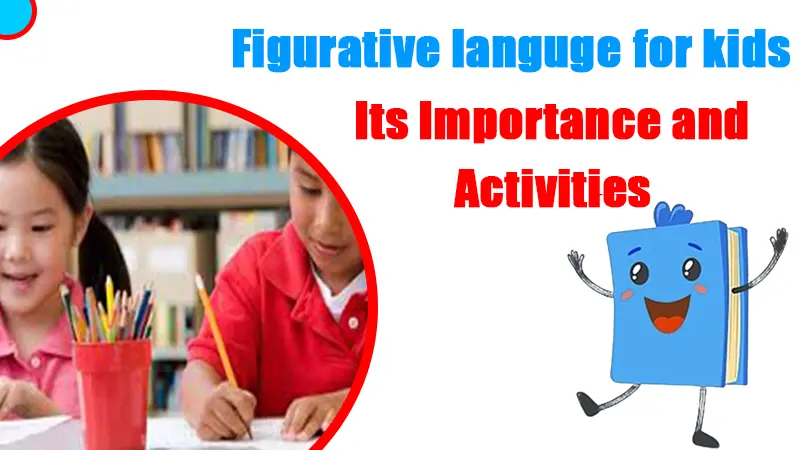Did you ever stop to think that when your child describes a delicious cake as “melting in my mouth,” they are using figurative language? Figurative language, including metaphors, similes, and personification, adds a vibrant layer to communication. It is something children naturally gravitate towards, enhancing their vocabulary, creativity, critical thinking, and communication skills.
In this blog, we are going to talk about figurative language for kids, exploring its definition and importance, and providing fun activities and resources to aid learning.
Understanding Figurative Language
Figurative language is a way of using words that go beyond their literal meaning. It is like painting with words, using vivid imagery and unexpected comparisons to create a deeper impact on the reader or listener. Figurative language can be used to make writing more interesting, memorable, and emotionally engaging.
Figurative language is like a secret code that adds flair to words, making them more exciting and expressive. For kids, it is a playground of creativity where words take on a life of their own. Imagine comparing a fluffy cloud to a giant cotton candy ball, that’s a simile! Similes use ‘like’ or ‘as’ to compare two things that are different but have something in common.
Other types of figurative language include metaphors, personification, hyperbole, and onomatopoeia. Metaphors make direct comparisons without using ‘like’ or ‘as.’
For example, describing a friend as a “ray of sunshine” is a metaphor. Personification gives human characteristics to non-human things, like a talking tree or a giggling cookie jar. Hyperbole involves exaggeration for emphasis, while onomatopoeia imitates the sound it describes, such as ‘buzz’ or ‘boom.’
Why is Figurative Language Important?
Figurative language is more than just a linguistic tool; it’s a gateway to various developmental benefits for children:
Vocabulary Development: By exploring figurative language, kids encounter new words and understand their different meanings, expanding their vocabulary.
Creativity and Imagination: Figurative language allows children to express themselves in new and exciting ways, fostering creativity and imagination.
Critical Thinking: Understanding deeper meanings and making connections between words develops critical thinking skills, enhancing cognitive abilities.
Communication Skills: As kids become adept at using figurative language, they become more effective communicators, able to convey complex ideas with nuance.
Real-life examples abound, from a child describing a playground as a “jungle of fun” to a story where animals talk and behave like humans. These instances show how figurative language is an inherent part of children’s play, writing, and conversations.
Fun Activities & Resources for Learning Figurative Language

Learning a figurative language can be an exciting journey for kids, enhancing their language skills and creativity. Engaging in fun activities and utilizing resources tailored to their age group can make the process enjoyable and effective.
One effective approach is incorporating games and interactive exercises that make learning figurative language a playful experience. Here are some ideas and resources to make the learning process enjoyable:
Figurative Language Bingo: Create bingo cards with various figurative language elements such as similes, metaphors, and idioms. As you introduce examples, kids can mark them on their cards, fostering recognition and understanding.
Interactive Storytelling: Encourage kids to create their own stories or re-imagine existing ones using figurative language. This not only allows them to practice using these elements but also sparks their imagination.
Figurative Language Scavenger Hunt: Create a list of figurative language examples and challenge kids to find them in books, movies, or everyday conversations. This activity helps reinforce recognition skills.
Online Games and Apps: Explore educational websites and apps that specifically focus on teaching figurative language in a fun way. Many platforms offer interactive games and quizzes tailored to different age groups.
Creative Arts and Crafts: Combine creativity with language learning by having kids create visual representations of figurative language. For example, they can draw illustrations for idioms or create a metaphorical collage.
Figurative Language Song Lyrics: Analyze song lyrics together to identify and discuss various figurative language elements. This approach connects language learning with music, making it enjoyable and relatable.
Storytelling with Puppets: Using puppets to act out stories with figurative language elements can be a delightful way for kids to understand and remember these concepts.
Tips for Adults & Parents
As parents and educators, you play a pivotal role in nurturing a child’s understanding and use of figurative language:
1. Model Figurative Language: Incorporate figurative language into everyday conversations, showcasing its use naturally.
2. Point Out Examples: When encountering figurative language in books, movies, or songs, point it out and discuss it with your child, encouraging their understanding.
3. Encourage Creativity: Provide ample opportunities for kids to express themselves creatively through writing, drawing, or even drama, allowing them to experiment with language.
4. Be Patient: Learning a figurative language is a journey that takes time and practice. Celebrate your child’s efforts and progress, fostering a positive learning environment.
Conclusion
A figurative language is a powerful tool that opens up a world of expression and creativity for children. By embracing its magic, parents and educators can contribute to the holistic development of their young ones. So, go ahead, explore the wonders of figurative language with your kids, turn ordinary moments into extraordinary adventures, and watch as their language skills blossom.
-
Understanding Figurative Language – The Role of Translators in Identification
Figurative language, such as metaphors, similes, and personification, enriches narratives by layering meanings beyond the literal. These literary devices are […]
-
Fragment VS Complete Sentence: Understanding the Difference with Examples
Understanding sentence structure is fundamental to effective communication in any language. Whether you are writing an essay, crafting a business email, […]
-
Enhance Learning with Engaging Figurative Language Posters
Figurative language posters are visual aids designed to illustrate and explain various forms of figurative language, such as similes, metaphors, […]



